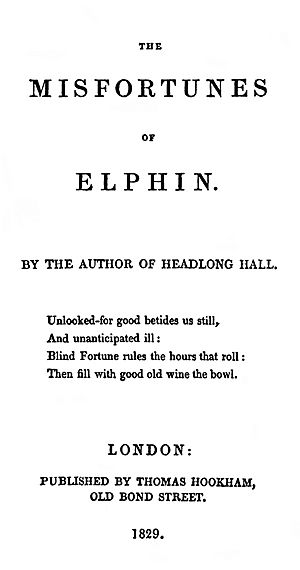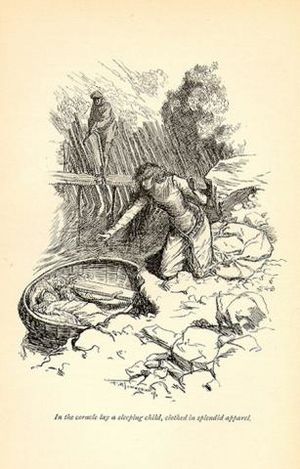The Misfortunes of Elphin facts for kids
The Misfortunes of Elphin is a short adventure story written by Thomas Love Peacock in 1829. It takes place in Wales during the 500s. The story follows the exciting journeys of a poet named Taliesin, princes Elphin ap Gwythno and Seithenyn ap Seithyn, and the famous King Arthur.
Peacock studied old Welsh stories and poems to write this book. Many of these old texts had not been translated into English yet. He included many poems, some based on ancient Welsh songs, and some he wrote himself, like "The War-Song of Dinas Vawr." The book also makes fun of the political ideas of his time, especially those of the Tory party. Many people praise Elphin for its clever humor and consider it one of the best King Arthur stories from the Romantic period.
Contents
What is The Misfortunes of Elphin About?
The story begins in the early 500s in the Caredigion kingdom. King Gwythno Garanhir rules this land. His officer, Prince Seithenyn ap Seithyn, is in charge of the walls that protect the flat land of Gwaelod from the sea.
One day, an official named Teithrin ap Tathral discovers that the sea wall is falling apart. He tells Elphin, who is King Gwythno's son. Elphin then meets Angharad, Seithenyn's beautiful daughter. They watch as a huge storm hits, destroying the sea wall. The sea rushes in and floods the land. Seithenyn, acting bravely, jumps into the waves with his sword. Teithrin, Elphin, and Angharad manage to escape to King Gwythno's castle.
King Gwythno is very sad that the best part of his kingdom is now under Cardigan Bay. Elphin marries Angharad and starts a new life, making money from a salmon trap he built. One day, he finds a baby in a small boat in his trap. He names the baby Taliesin and raises him along with his own daughter, Melanghel. As Taliesin grows up, he learns about Druidism and becomes a bard (a poet and storyteller).
King Gwythno dies, and Elphin becomes the king of the smaller, poorer kingdom of Caredigion. But soon, Maelgon, the king of Gwyneth, captures Elphin. Taliesin, encouraged by Melanghel, whom he loves, sets out to free Elphin.
At Maelgon's court, Taliesin announces he is Elphin's bard. He defends Angharad's good name and enters a poetry contest with Maelgon's bards. During the contest, he warns Maelgon about bad things to come, like an attack by King Arthur and a deadly sickness. Taliesin returns to Caredigion.
Rhun follows Taliesin, wanting to try and win Angharad again. But he is tricked into a cave and trapped when a large rock seals the entrance. Taliesin then goes to find King Arthur in Caer Lleon. On his way, he stops at Dinas Vawr, a fort just captured by King Melvas. Melvas's men are celebrating with wine and songs. Taliesin is amazed to find Angharad's father, Seithenyn ap Seithyn, among them. It turns out Seithenyn survived the great flood many years ago!
Taliesin reaches Caer Lleon and is impressed by its beauty. He gets to meet King Arthur, who is celebrating Christmas happily, even though his wife Gwenyvar has been taken by someone. Taliesin tells the king a secret he learned from Seithenyn: Gwenyvar is being held by Melvas.
Taliesin then travels to Avallon, where Gwenyvar is captive. He hopes to talk Melvas into releasing her peacefully. There, he meets Seithenyn again, along with the abbot (leader) of Avallon. Both agree to help him. The three of them convince Melvas that it's better to release Gwenyvar to Arthur willingly than to face Arthur's anger.
Back in Caer Lleon, Taliesin takes part in another bardic contest. Other famous bards like Llywarch, Merlin, and Aneirin perform their poems. But Taliesin's poem, from the Hanes Taliesin, is declared the best. Seithenyn and the abbot then arrive, bringing Gwenyvar with them. After returning her to Arthur, they tell him that Taliesin was key to her release.
The grateful king grants Taliesin a wish. Taliesin asks Arthur to order Maelgon to free Elphin. Maelgon himself appears at this moment and unwillingly agrees to Arthur's command. Arthur sends someone to bring Elphin, Rhun, and everyone else involved, including Melanghel. The story ends with Taliesin marrying Melanghel and being chosen as the Chief of the Bards of Britain.
How the Book Was Written
Peacock was very interested in Welsh culture long before he wrote The Misfortunes of Elphin. He took walking trips to Wales several times between 1810 and 1811. He likely used what he saw and learned during these trips in his book. He was good at languages and started learning Welsh around this time.
In 1820, he married a Welsh woman named Jane Gryffydh. It's thought that she either taught him Welsh or helped him translate old Welsh texts. Elphin clearly shows a deep knowledge of early Welsh stories, some of which were not available in English back then. It's also believed that his wife inspired the characters of Angharad and Melanghel.
Peacock wrote Elphin at his home in Lower Halliford, Surrey, where he moved in 1822. He included 14 poems in his story. Most of these were loose translations or adaptations of old bardic poems by poets like Taliesin and Myrddin. However, some, like "The War-Song of Dinas Vawr," were entirely his own.
Elphin was published in March 1829, seven years after his previous book, Maid Marian. It might have taken a long time to write because Peacock had a full-time job and was busy managing his friend Shelley's affairs after he died. Also, his research for the book was very detailed.
Where the Story Ideas Came From
Peacock's use of old Welsh stories and poems was quite unusual for his time. Back then, many people outside Wales didn't think these stories were suitable for literature. While he stayed true to the spirit of the old tales, he made the supernatural (magic and spirits) less important in his version.
The main structure of Elphin comes from three ancient Welsh stories:
- The flooding of Gwythno's kingdom because Seithenyn was careless.
- The birth and prophecies (predictions) of Taliesin.
- The kidnapping of Gwenyvar by Melvas.
The first story about the flood is found in an old poem called the Black Book of Carmarthen. Peacock also found it in two English books: Samuel Rush Meyrick's History and Antiquities of Cardigan (1806) and T. J. Llewelyn Prichard's poem The Land Beneath the Sea (1824).
The Taliesin story comes from the Hanes Taliesin. This full story wasn't available in English or Welsh in the 1820s. But Peacock could find summaries and parts of it in books like Edward Davies's The Mythology and Rites of the Druids (1809).
Peacock's version of the story about Arthur, Gwenyvar, and Melvas comes from a 12th-century Latin book called Vita Gildae. He likely read about it in Joseph Ritson's Life of King Arthur (1825).
The poems in Elphin are mostly translated or copied from originals found in Owen Jones's Myvyrian Archaiology (1801–1807). Peacock also used Welsh triads (short sayings grouped in threes) that he found translated in a journal called The Cambro-Briton (1819–1822).
The detailed description of Caerleon in the book comes from Richard Colt Hoare's 1806 translation of Gerald of Wales's travel books, Itinerarium Cambriae and Descriptio Cambriae. Other descriptions of places likely came from Thomas Evans's Cambrian Itinerary and Peacock's own memories of his trips to Wales.
Satire and Humor in the Story
Besides being an adventure story, The Misfortunes of Elphin is also a clever attack on the political ideas of the Tory party at the time. Satire means using humor, irony, or exaggeration to criticize people's foolishness or vices.
For example, Gwythno's dam (the sea wall) represents the British constitution. Seithenyn's speech, where he says the wall doesn't need fixing, sounds like speeches by George Canning who was against changing the constitution. The flood itself can represent the need for big changes, or even the French Revolution.
Peacock also makes funny comments about how "progress" isn't always good. He criticizes the wealthy clergy of the Church of England through his description of the "plump, succulent" abbey of Avallon. He also makes fun of things like new factories, the idea of utilitarianism (doing what's best for the most people), and bad taste in literature.
However, Peacock doesn't make his medieval characters perfect just to make fun of his own time. Arthur isn't too upset about his wife being gone, and Gwenyvar has her own flaws. Merlin, who seems magical, is actually just a scientist. Peacock believed that human nature, with all its imperfections, was pretty much the same throughout history.
The book is enjoyable for readers today because it mixes clever humor with simple good fun. Many people describe its humor as "comic genius of the highest order."
One of the funniest and most memorable characters is Seithenyn. He's been called "one of the immortal drunkards in the literature of the world." He's a funny, friendly character whose way of talking, though a bit twisted by drink, is often compared to the famous character Falstaff. Many critics believe Seithenyn is Peacock's greatest character.



